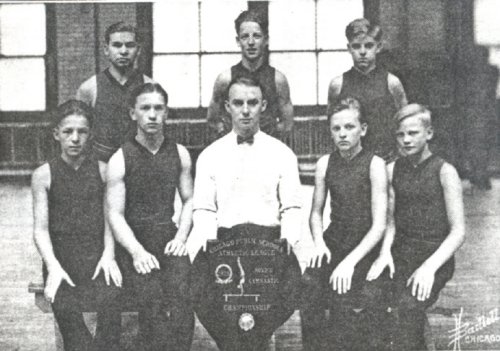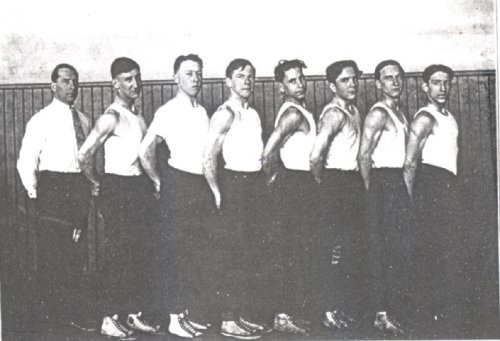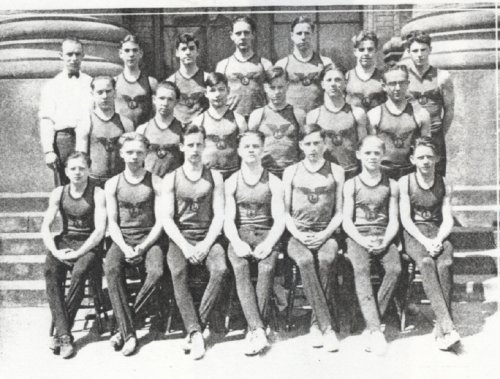Pioneers
Boys Gymnastics Before IHSA Sponsorship
By ROBERT PRUTER
A landmark year in the history of high school gymnastics in Illinois was certainly 1958, when the IHSA sponsored first state championship meet. But the story of gymnastics did not begin with 1958. It had a long star-studded history prior to the first IHSA meet, and that history included an invitational state meet held under the sponsorship of the University of Illinois from 1952 to 1957.
High school gymnastics in Illinois was the product of some far-sighted, hardworking individuals who had pioneered the sport for decades trying to build interest. Gymnastics originated as an ethnic sport, practiced by Czechs and Slovaks in Sokol Clubs and by Germans in Turner Halls. It was a Czech-American from the West Side of Chicago, Henry Smidl (1894-1985), who almost single-handedly introduced the sport to Illinois high schools.
Smidl, a member of Sokol Chicago at 24th and Kedzie, was the national Sokol all-around champion from 1919 through 1926. He captained the United States gymnastics team in the World Gymnastics Championships in Prague in 1920 and 1926. In 1919, he began teaching at Englewood High on the South Side and there began an intramural gymnastics program. Itching for competition, in 1924 Smidl persuaded the Public League to sponsor a team championship in the sport. He recruited two other schools to form teams and to participate, Harrison High and Lane Tech. Harrison was located in a West Side Czech neighborhood, and many of its students belonged to Sokol Chicago where Smidl also instructed in gymnastics.
The following year Smidl moved to Lindblom, where he proceeded to create a gymnastics dynasty. Interrupted only by a three-year stay at Gage Park High in the early 1940s, Smidl won 24 senior titles for the school before his retirement in the late 1950s. Was he one of those hard taskmaster coaches and was that the reason for his extraordinary results? "Not at all," recalls his one-time student, Bill Roetzheim, "Henry Smidl was a very easy going coach. By him being head of the school's athletic department he did something that was not common then but is common now. He arranged that all the gymnasts would have P.E. the last period of the day, and thus could begin practice an hour earlier."

Lindblom's 1925 Junior Public League Champions

Senn, 1926

Lindblom, 1928
The Public League system of competition was different from the system we know today. As Roetzheim relates, "The Chicago schools had three levels of competition in which points could be scored — novice, intermediate, and championship — and the reason Smidl won all those championships was that he put equal emphasis on all three levels. Some rival coaches just concentrated on the championship level."
After about a decade, however, Lindblom was challenged by another gymnastics power, Senn, whose team was coached by Al Bergmann, a product of the Turners. He had helped make Lincoln Turners on the North Side a national power. Throughout the 1940s and 1950s the two schools battled for the league championship. During that period Senn produced a host of great gymnasts, the trampoliner Gay Hughes, as well as the Shanken twins, Courtney and Earl, all of whom went on to the University of Chicago to win NCAA titles. Two later Senn gymnasts, Ronnie Amster and Mike Aufrecht, also won NCAA titles.
Lane Tech, an also-ran in gymnastics in the 1940s, had a champion in Irvin Bedard, one of the greatest tumblers the state of Illinois ever produced. He took the city title four years straight, 1942-1945. "He was a fabulous tumbler," remembers Giallombardo. "His father, who worked for the Chicago Park District, was his coach. When Irv was ten years old he went to the national AAU meet with me. He competed against college kids, but it was an exhibition, even though he was sensational. He was ineligible because he wasn't 14 or 15." In 1960 Bedard would start the gymnastics program at West Leyden; he also founded the Illinois High School Gymnastics Sports Association.
Smidl produced one of the most expert gymnasts ever to come out of Illinois schools, Bill Roetzheim, who was a Turner product. In 1944 and 1945 he took the Public League title with unheard-of high scores, and helped regained the team championship for Lindblom from Senn. Roetzheim later participated in two Olympic Games and won multiple national championships in both the NCAA and the AAU. Today he is one of the nation's most respected authorities on gymnastics and an international official in the sport.
The University of Illinois, under coach Hartley Price, was the first dominant college power in gymnastics and established its pre-eminence by recruiting from Chicago schools and from Cleveland, another hotbed of gymnastics. Among their Cleveland recruits was Joe Giallombardo, who discovered gymnastics at Cleveland East Tech and who honed his skills in the Turners. While at Illinois he won more NCAA titles than any other gymnast in history. In 1940 he was recruited by New Trier to teach and begin a gymnastics program. The program was rudimentary at first, with Giallombardo conducting a few exhibitions with the city powers, Senn and Lindblom.
Among his students was Don Von Ebers. "Joe Giallombardo was such a great gymnast," recalls Von Ebers. "He inspired me to work hard to become a good gymnast and to make teaching and gymnastics my career. I patterned my life after him." Von Ebers was the coach of the state championship Hersey team of 1974 and was instrumental in forming the National High School Gymnastics Coaching Association.
Giallombardo's progress was interrupted by World War II, but upon his return to New Trier in 1946 he established a gymnastics program on firm footing. In 1952, Giallombardo and several coaches around the state got together with the then University of Illinois coach, Charlie Pond, to establish the first invitational state meet. Pond, who maintained Illinois' extraordinary success in the sport throughout the 1950s, saw the meet as a recruiting tool as well. Recalls Giallombardo, "We got together and said let's hold a contest. And we sent out letters and information and that's how we got started."
The inaugural meet, held in the first week of May, was a modest event, attracting only five schools — New Trier, Chicago University, Carmi, Zion-Benton, and Macomb. The Chicago public schools showed no interest in the invitational. New Trier won the meet, and one of its gymnasts, Don Hampton, won the most outstanding gymnast award. There was no all-around competition in the first years of the meet. The horizontal bar winner, Jon Culbertson, from New Trier, was an Olympic Games alternate in 1960. Culbertson is now an international judge in the sport.
In the fall of 1951, Gay Hughes, who won the very first NCAA title in the trampoline in 1948, began teaching at Arlington High. The first year he established a trampoline club, but the second year he formed a full-fledged gymnastics team. He took that team to the second annual state meet and had remarkable success, taking second to New Trier in a six-team meet. The other teams were all from downstate — Carmi, Canton, Champaign, and Macomb Western.
Also in the fall of 1951, Don Von Ebers joined the Leyden staff and began a gymnastics program. "Athletic director Sam England," says Von Ebers, "was looking for a teacher who could start a gymnastics program. He thought highly of gymnastics and wanted it introduced into Leyden." Von Ebers began working at first with underclassmen and did not field his first varsity squad until 1954, when he took his team to the third state tournament. "We got old used equipment to start with," recalls Von Ebers, "and had to scramble quite a bit. And we had cramped inadequate space until the field house was built in 1957."
It was in the 1954 state invitational that the old man of Illinois high school gymnastics, Henry Smidl, finally had his turn. He apparently disdained the meet the two previous years, but had finally decided to join the fun competing against eight schools. "He had some outstanding gymnasts that year," recalls Giallombardo, "and wanted to show them off." Lindblom edged New Trier for the title. Arlington took third and was followed by Carmi. Other schools participating were Roosevelt and South Shore of Chicago; and Leyden, Glenbrook, and Champaign. Sanford Horn of Roosevelt won the outstanding gymnast award. Tumbler Frank Hailand of South Shore, who finished third in the state meet, would later win two NCAA championships.
As powerful as the presence of the Chicago schools in the 1954 meet it was clear that gymnastics competition was shifting towards the suburbs, where students of Smidl and Bergmann were starting up programs. "At a banquet all us coaches were attending," relates Giallombardo, "I can remember Henry Smidl saying 'You guys will be taking over in a few years.' We simply had the younger coaches in the suburban schools."
In 1955 it was Arlington's turn to take the state invitational, which was now moved up to mid-March. John Koeppen of Arlington took three firsts — on the rings, horizontal bar, and long horse. His vault on the long horse according to Charlie Pond "was the best he had seen in high school or college in the past five years." Lindblom was second, followed by Senn and New Trier. Leyden, Carmi, and Jacksonville completed the field. There should have been more than seven teams in the field — as there were at least ten other schools in the state that year that had teams and chose not to compete.
In 1956, New Trier beat out Arlington for first in an eight-team field. The New Trier team was anchored by two future NCAA titlists — sophomore Ray Hadley who took first in all-around (new in 1956), tumbling, and trampoline; and junior Bill Buck, who took first in side horse and parallel bars. Senn and Lindblom took third and fourth respectively. A new school in the meet was York High, which under coach Vic Lesch was fast building a program. An up-and-coming sophomore on the York team was Fred Tijerina, who would win the NCAA title on parallel bars in 1961. Proviso under first-year coach Bill Roetzheim had a team that year, but it was a young squad hampered by lack of equipment and the school chose not to participate in the meet.
The 1957 meet saw New Trier again in the top spot. Hadley took first in the all-around and three individual events. Senn took second, and entering a team comprised largely of underclassmen, Proviso surprised the eleven-team field by taking third. Newcomers to the meet were Maine and Moline. The tumbling champion was a remarkable sophomore Hal Holmes from Urbana High. He was an early protege of Charlie Pond and by his senior year won the first of four consecutive AAU national championships. "He was incredible," recalls Giallombardo. "He was the first high school boy to do a double back somersault. That was unheard-of then."
By the 1957 season the IHSA had seen that gymnastics was growing steadily, and made the decision to sponsor the next year's meet. "There really were not a sufficient number of schools under the IHSA rules to begin official sponsorship," explains Von Ebers, "but the IHSA began sponsorship on a trial basis in hopes that it would grow. And it did grow."
But there was no growth in Chicago, where the sport was in decline. Roetzheim explains, "It was just the facilities. When the suburban schools opened up to gymnastics their facilities were just so superior. The Chicago schools couldn't compete with just two gyms — a girls' and a boys'. Plus, the glue that held the Chicago program together — Henry Smidl and Al Bergmann — both of them were up there in age and had retired by the end of the decade." Punctuating Roetzheim's remarks, Giallombardo says, "Smidl and Bergmann were up in years, and I don't think they pushed the sport as much as we did."
By 1958 Smidl was gone and Lindblom no longer had a team. In 1959, Bergmann led Senn to its fifth consecutive city championship and then retired. But with his retirement Senn dropped the sport. Thus it would be in the suburbs where the sport would flourish under IHSA sponsorship.
Many thanks to Stanley Barcal, Irvin Bedard, Joe Giallombardo, Bill Roetzheim, and Donald Von Ebers for so graciously providing interviews.
Published with permission. All rights are reserved by the author.
The opinions expressed in this article are those of the author and not necessarily those of the Illinois High School Association.